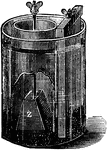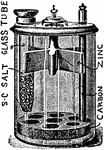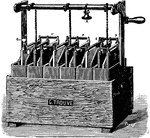Clipart tagged: ‘bichromate’

Fuller Bichromate
The cell was set up in a glass, or glazed earthenware, pot. This contained the chromic acid solution,…

Partz Cell
"Partz acid gravity cell. In this form of cell, the electrolyte which surrounds the zinc is either magnesium…

